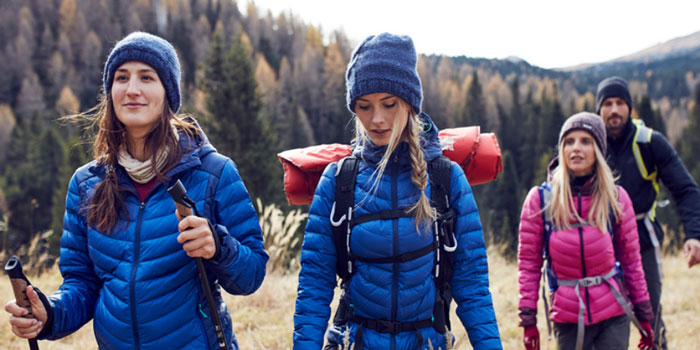Although walking outside in the winter can be difficult, it can also be a great way to get some much-needed exercise and appreciate the season's beauty if you come prepared and keep the appropriate frame of mind. When venturing out on a winter walk, it's essential to dress in layers that keep you warm and dry while protecting you from the wind and cold. Keep your hands, feet, and head warm to avoid unnecessary discomfort. Wear shoes or boots with appropriate traction devices to protect yourself from falling on ice.
Be mindful of your surroundings and frequently stop to warm up and rest when walking in the cold. You can improve your chances of arriving at your destination safely in an emergency if you take the time to plan your route and let someone know where you're heading. Finally, it is always best to have a fully charged phone in an emergency. These suggestions can help you stay healthy and active this winter.
Winter Walking Tips
Dress In Layers:
You can keep warm and cozy while out for a walk in the winter if you dress in several layers. You should wear a moisture-wicking base layer to prevent sweat from accumulating on your skin, an insulating layer to keep warm, as well as a windproof as well as waterproof outer layer to ward off the elements.
Wear Gloves and Protect Your Fingers!
Make sure your extremities, especially your hands, feet, and head, are warm enough. Put on some insulated boots, some warm mittens, and something to keep the cold off your head and ears.
Use Traction Devices:
Walking on snow and ice can be treacherous, so it's essential to use traction devices on your shoes or boots to prevent slips and falls. Various options are available, such as slip-on spikes or cleats that can be worn over your shoes.
Be Aware Of Your Surroundings:
In the winter, visibility can be limited, so paying attention to your surroundings is essential. Look out for icy patches, snow-covered sidewalks, and other hazards that could cause you to slip or fall.
Watch For Signs Of Hypothermia:
Hypothermia is a severe condition when your body temperature drops below normal. Symptoms include shivering, confusion, drowsiness, and loss of coordination. If you experience any of these symptoms while walking in the cold, seek medical attention immediately.
Take Regular Breaks:
Walking in the cold can tax your body, so taking regular breaks to rest and warm up is essential. Find a warm place to take a break, such as a coffee shop or library, and warm up with a hot drink or snack.
Plan Your Route:

It is a good idea to map your walking path and let someone know where you are heading before you go on your excursion. If someone knows the direction you intend to take, it will be much simpler for them to locate you in the event you get lost or stuck.
Bring A Phone:
It would be best if you always had a phone on you that is well charged and always had it with you in case of an unforeseen incident. You should also always have it with you.
Check The Weather:
Check the forecast before going on a stroll, and make sure your outfit is appropriate for the conditions. If the weather is especially severe, you should probably remain inside. It's safer that way.
Keep It Short:
If this is your first winter walking experience or the weather is unusually bad, you should begin with shorter excursions and work your way up to longer ones as your fitness level improves.
Keep Your Energy Level Up:
It is essential to have a nutritious and well-balanced meal before going outside since walking in the cold may be exhausting. Bring some snacks with you so you don't become hungry while on your stroll.
Check Your Gear:

Check that everything you need to bring along with you is in excellent functioning before you leave. This includes your boots, gloves, cap, and any other gear or equipment you will use throughout the activity.
Conclusion
In conclusion, Winter walking can be a fun and stimulating experience with the proper preparation and mindset. By following the tips provided, such as dressing in layers, protecting your extremities, using traction devices, being aware of your surroundings, taking regular breaks, planning your route, watching for signs of hypothermia, bringing a phone, and checking the weather, you can stay safe and comfortable while enjoying the beauty of the winter season. Remember to check your gear before heading out, and always carry a fully charged phone with you in an emergency. With a bit of preparation and common sense, you can continue walking comfortably and safely throughout the winter.

How Many Calories Are In A Watermelon?
Oct 08, 2023

Grow Stronger Hair with the Best Hibiscus Shampoos
Jul 24, 2024

Finding the Perfect Sunscreen for Sensitive Skin
Jul 24, 2024

Pneumonia Prevention: 5 Easy Steps
Dec 01, 2023

Discover 6 Causes of Dark Underarms and How to Lighten Them
Mar 12, 2024

What You Should Be Aware Of About Focal Hyperhidrosis
Nov 23, 2023

Here Are 5 Foods to Eat If You Have the COVID-19 Virus
Dec 25, 2023

Is Your Skin Peeling Around Piercing? Find Out The Reasons!
Mar 12, 2024



